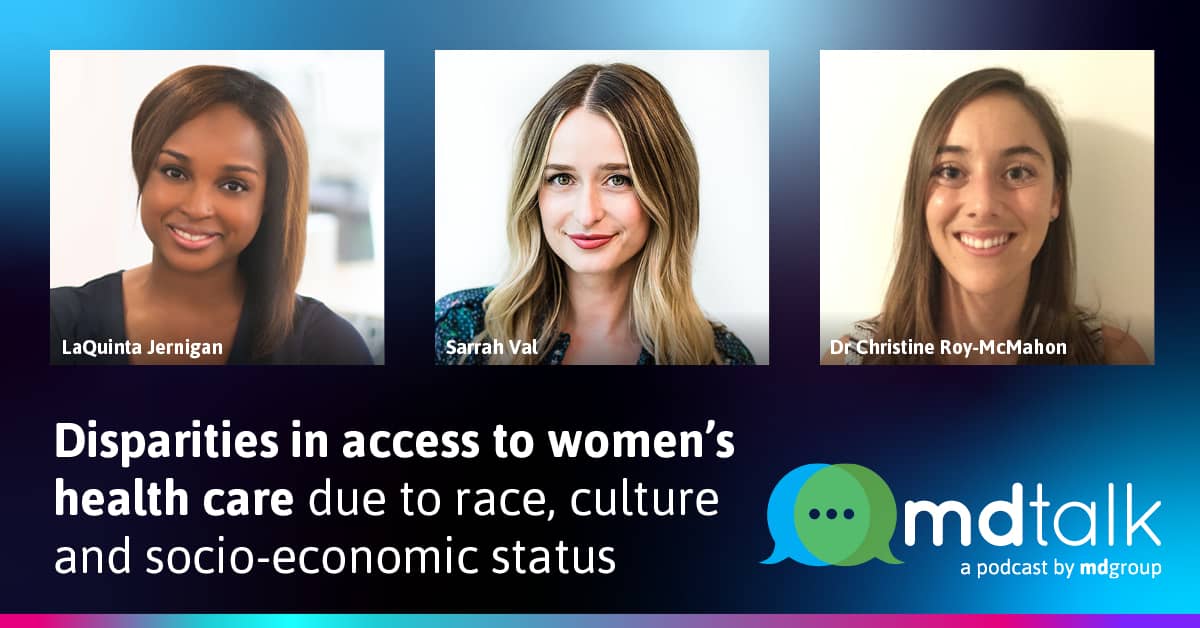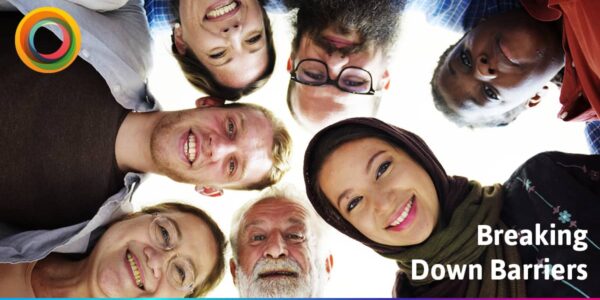
Welcome to episode seven of mdtalk. Through this podcast and video series, we’re on a mission to highlight the most important issues impacting clinical research, the patient experience and the future of healthcare.
Listen to the episode below, on Spotify, Apple podcasts, or wherever you get your podcasts.
This episode is focused on women’s health, and how disparities in access to care due to race, culture and socio-economic status can and must be addressed. As well as discussing the causes and solutions to this issue, the hosts will also consider how healthcare accessibility relates to clinical research today.
LaQuinta Jernigan, Chief Operating Officer at mdgroup, and co-host Sarrah Val, our Regional Sales Director for the Americas, speak with Christine Roy-McMahon MD, attending OB-GYN at Elmhurst Hospital HHC.
Dr Roy-McMahon has a Major in neurobiology from the Florida International University Herbert Wertheim College of Medicine with a sub-specialism in benign gynaecological surgery, focusing on minimally invasive techniques. She primarily takes care of uninsured, underinsured and underrepresented minorities and is passionate about working on equity of care and access for those groups.
Episode overview
LaQuinta begins the episode by highlighting some shocking statistics around healthcare disparity in the United States:
- Reports show Black women in the United States are more likely to die from pregnancy or childbirth than women in any other race group
- According to a 2014 report in the American Journal of Obstetrics & Gynaecology, black women experience higher rates of unintended pregnancies than all other racial groups, in part because of disparities in access to quality contraceptive care and counselling.
- A 2011 study published in the National Library of Medicine found that the legal status of immigrant mothers is one of several important factors influencing prenatal care utilisation. Undocumented women are among the least likely to obtain adequate levels of prenatal care.
LaQuinta, Sarrah and Dr Roy-McMahon discuss these statistics along with other reasons for healthcare access disparities, exploring what Dr Roy-McMahon considers the biggest challenges and solutions are on the road ahead.
How access to prenatal and maternal care is impacted by race, culture and socio-economic status
Teasing out social determinants of health from race, culture and socio-economic status is almost impossible, Dr Roy-McMahon explains. A person’s race influences their culture, their culture influences the way they interact with the world, and both of these influence a person’s socio-economic status.
For immigrant populations, in particular, access is one of the biggest barriers to care. This could be due to external stressors such as time management, child care obligations, needing to provide for their families etc, but it can also be an educational issue.
The complexities of the American healthcare system also create a blocker to healthcare access, explains Dr Roy-McMahon. She describes how the system is particularly difficult to navigate for immigrant women who may struggle to understand what care is available to them, how to register for it, and how to take autonomy for their own care.
Dr Roy-McMahon suggests education as a solution. In New York, for example, subway ads are strategically placed amongst diverse communities, with posters in different languages to explain how to navigate the healthcare system.
The role of gynaecological care in overall preventative health
Childbirth is an opportunity to introduce immigrant women into the care systems they might not otherwise know about, explains Dr Roy-McMahon.
Contrary to popular belief, in many US states, pregnancy and the immediate postpartum period is one of the few times where you’re covered by Medicaid regardless of your income or other insurance status.
Dr Roy-McMahon describes how in her own practice, she has encountered women during their prenatal course who she has been able to guide towards resources for gynaecological care within the public hospital systems. These women are more likely to come back for preventative health care, and get picked up by all the other services that they might need later in their life.
Perception and education around gynaecological care can differ across demographics and different cultures, according to Dr Roy-McMahon. She said: “I encounter a lot of women in my practice who may not know that it’s not normal to have a period so heavy that you’re anaemic every single month, and that you don’t have to live that way”.
“Medicine and gynaecological care can just be about modifying your life and not just about preventing things like cancer or dealing with pregnancy or other outcomes. So there’s definitely a role for education for those women. Gynaecological care has a lot more to offer than just pregnancy and delivery”.
Tackling cultural barriers to women’s health access
LaQuinta notes there may be cultural barriers to seeing a gynaecologist because, in some cultures, it’s seen as something that should not be happening until a woman is sexually active.
Dr Roy-McMahon agrees that gynaecological health needs to be repositioned as comprehensive women’s health, and not stigmatised or treated as taboo. Instead, women’s health should be as important as cardiac or mental health, and campaigns that are running currently are seeking to position gynaecological care in this way. Dr Roy-McMahon sees this “demystification” of women’s health care as an important first step.
Sarrah agrees there should be a lot more education, especially at a younger age, about women’s health, that’s not restricted to sex education, but also includes awareness of other common issues such as fibroids or the importance of pelvic floor exercises.
Misdiagnosis in women’s health
Dr Roy-McMahon notes a common theme that many women are still seeing generalised providers for OB-GYN needs, which can lead to misdiagnosis. This can arise from providers not feeling comfortable talking about issues relating to gynaecological health, or not knowing the appropriate questions to ask, and patients not feeling comfortable in providing that information.
GYN is a speciality that is complex and interplays with a lot of other medical conditions, and requires an appropriate provider.
Misdiagnoses can also occur due to perceived pain thresholds. Women are known to have higher pain thresholds, but are conversely taken less seriously about chronic pain by medical professionals. This can lead to compounding problems, as Dr Roy-McMahon explains. For example, women suffering from endometriosis typically experience severely painful periods. Without early diagnosis, a woman can suffer needlessly for years, with untreated endometriosis sometimes requiring surgery and later affecting their fertility planning. If endometriosis was caught earlier on in the disease course, it could be managed more effectively.
How patients can make their voices heard
It is very important to teach patients to advocate for themselves and to make sure that their voices are heard, Dr Roy-McMahon stresses. For patients who don’t speak English as their first language, an appropriate interpreter service might be needed to understand complex medical information and build trust and openness.
LaQuinta notes how there is also mistrust by people from some minority groups in the medical system, particularly for black women, due to historical issues in the US such as the Tuskegee studies. Trust is a critical issue, and much more work is needed to more effectively engage communities, potentially through working closely with community leaders.
The importance of diversity in clinical trials
LaQuinta highlights how the FDA is now supporting the inclusion of racial demographics in research, and a lot of companies are setting goals to make sure diversity is well embedded in their clinical trials strategy. She notes how vitally important this is.
Dr Roy-McMahon agrees: “The point of research is to create data that can then be generalizable to our population. If our research studies don’t reflect our diverse population, then we can’t appropriately draw conclusions and tell what those products are going to do in terms of the people that we’re trying to take care of”.
“The more diversity that we have within research and clinical trials, the more able we are going to be to take those findings and apply them to real medicine”.
Diversity in clinical trials can also help minority groups feel represented, and part of the progression of research and medicine as a whole.
Clinical trials should be a public health initiative that’s just as important as teaching our kids to “stop, drop and roll” in the case of fire, suggests Sarrah. She believes children should grow up with an understanding of how clinical research impacts not only the individual, but the quality and access of care available to everyone.,
By demystifying clinical research, people can see that strides are happening for the greater good.
For more content around the most important issues in clinical trials, patients and the future of medical research, follow us on social media on Twitter, find us on LinkedIn, and subscribe to our YouTube channel.







